|
Drag force and Drag Coefficient
A particle suspended in a fluid is subjected to a number of hydrodynamic forces. For low Reynolds number flows, the Stokes drag force on a spherical particle is given by
where d is the particle diameter, µ is the coefficient of viscosity and U is the relative velocity of the fluid with respect to the particle. Equation (1) may be restated as
 |
(2) |
In Equation (2), ρ is the fluid (air) density,  is the cross sectional area of the spherical particle, and is the cross sectional area of the spherical particle, and
 |
(3) |
is the Reynolds number. The Stokes drag is applicable to the creeping flow regime (Stokes regime) with small Reynolds numbers (Re<0.5). At higher Reynolds numbers, the flow of the drag coefficient deviates from Equation 2. Figure 1, below, shows the variation of the drag coefficient for a sphere in a range of Reynolds numbers. |
|
| Drag Force Calculation Models |
 |
Evaluate the drag force for a spherical particles in low Re flows.
|
 |

Evaluate the Drag Force for particles in flows with 1 < Re < 1000.
|

Evaluate the Drag Force for Spherical Liquid Droplets.
|
|













































